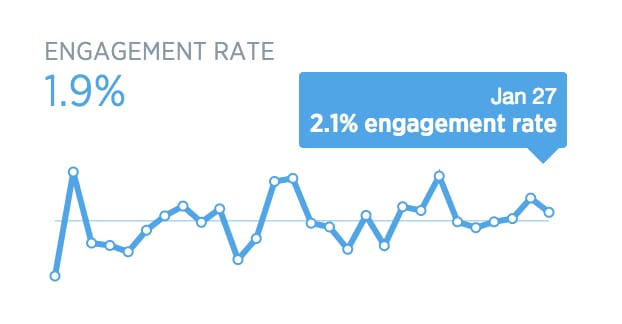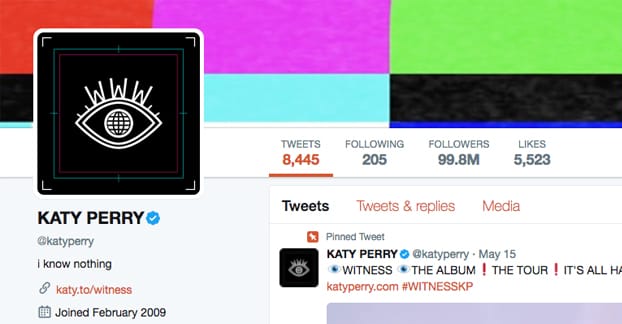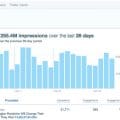A few years ago, everyone chased followers on social networks. The more followers you had, the better off you were. It didn’t matter whether they were bots, bought fans, or real people; the number was all that mattered.
Then came the wave of refutation. Posts sprang up on every marketing blog, often more than once, detailing why it’s not the number that matters, it’s the engagement. “Quality over quantity!” they would shout from the heavens, until brands had no choice but to listen to the choir.
These days, we all chase engagement. We don’t need millions of followers; we need thousands of engaged followers. We all chase engagement rates, but how often do we sit back to think of what is good enough?
Think about it. Remember when that study came out showing that Instagram has insanely high engagement rates? Brands flocked to Instagram by the thousands. No one gave any thought to whether or not their content was acceptable, valid, or valuable on a site focused around sharing images. No, they chased engagement rates because they heard Instagram was good, and they heard engagement was good.
So, we know a higher engagement rate is better, but what is considered “good” or “good enough” for the site? Looking at Twitter, we can do some analysis.
The Top Twitter Accounts
As an illustrative point, I’ve looked at the top three most followed accounts on Twitter to calculate their engagement rates. I’ve calculated an average from the most recent handful of tweets they’ve made.
- Katy Perry has 98,337,250 followers. Her recent tweets average about 18,000 accumulated engagement actions, for an engagement rate of .02%. It’s worth noting that they build up engagement over the course of a week, and that almost all of her recent tweets when writing this were advertising her new album.
- Justin Bieber has 94,446,901 followers. His recent tweets average about 162,600 accumulated engagement actions, for an engagement rate of .17%. It’s worth noting that he tweets very rarely, so all of these tweets are several days or weeks old and have had plenty of time to accumulate engagement. They’re also universally about his tour, calling locations amazing.
- Barack Obama has 88,277,291 followers. His recent tweets average about 616,020 accumulated engagement actions, for an engagement rate of .7%. Worth noting is that, as a popular and down-to-earth public figure, Obama inspires a lot of discussion, even if a lot of it ends up as flame wars and political arguments.
So the number one account in terms of followers doesn’t have a high engagement rate, only two hundredths of a percent. Meanwhile number three, with ten million fewer followers, has a much, much higher engagement rate. Of course, these accounts are unique; out of tens of millions of followers, I’m sure there are enormous numbers of fakes, irrelevant, and inactive accounts.
Of course, this estimate of engagement rate is likely inaccurate. I only average the five most recent non-retweet tweets each account had made. I also added up the engagement actions – likes, retweets, and replies – even though it’s likely to be redundant; one person can do all three, and anyone who retweeted or replied likely also liked the tweets. It’s accurate for engagement actions, but not necessarily engaged users. Additionally, a truly accurate engagement rate relies on the number of impressions, not the number of followers; it’s the rate of engagement among people who actually saw the tweet, not just the number of people who could potentially have seen it.
Plus, there’s always the fact that people can engage with a tweet without being your follower. There are a lot of extenuating factors, is what I’m saying.
If you want some more statistics, Social Bakers did a study of the top 25 brands and found that engagement rates came in around .07%. This is, frankly, a bit of a depressing number to see.
Think about it this way; if you have an account with 1,000 followers, an engagement rate of .07% is less than one action per tweet. If you get three likes, two retweets, and no replies, you’re still at a .5% engagement rate, which is significantly higher than the big brand average.
On top of all of this, there’s also the fact that what Twitter recognizes as engagement in their analytics is different from what the public can see as engagement. Twitter engagement actions are actually much more robust than the three little metrics beneath the post. Twitter factors in likes, retweets, and replies, of course, but they also add in follows, @mentions, and clicks to links of all sorts, including profile clicks, permalink clicks, link clicks, and clicks to expand truncated tweet chains. This means your engagement rate can be much higher than the public stats betray.
Assorted Factors
Here’s a list of all of the factors that can change your average engagement rate benchmarking.
- The number of followers you have. Smaller audiences are generally going to have better statistics. One engagement action when you have 100 followers is already a 1% rate, while 1 action when you have 1,000 followers is .1%.
- The industry of your business. Some industries do much better than others on various social networks. Medical, Engineering, and Chemical industries have some of the best rates on Twitter, while Software, Professional Services, and Machinery have some of the worst.
- Whether you’re B2B or B2C. Twitter is broadly focused on B2C interactions or C2C social engagement; the brand-to-brand communication isn’t as high. However, even that depends heavily on the industry; if everyone in your industry is using Twitter, you can gather quite a large audience. If no one else is using it, why would you bother?
- Whether you have a separate customer service account. While it can be a good idea to split your marketing and your customer service channels to different accounts, it does mean a lot of your engagement is shuttled off to that other account. However, this does allow for some good segmentation; how many of your engagement actions are based on problems you need to solve, versus how many actions come from legitimate interest and engagement with your brand?
- How active you are on the site. The more active you are, the larger the audience you can build, and the more you can interact with them.
- How often your content includes imagery and graphics. Graphical content does well on Twitter because it stands out amongst all the rest of the graphical content, unlike normal tweets, which can blend in.
- How often you engage with your users in return. As you might expect, actually interacting with your followers gives them more reason to continue interacting with you.
Additionally, there’s the fact that Twitter itself is probably one of the worst social networks for brands in general. Track Maven publishes annual reports and shows that Twitter is pretty low on the list, while sites like Facebook and Instagram are better, and even Pinterest is better for some industries, though others are inactive on it.
So What is a Good Engagement Rate?
There’s no easy answer to the question of what a good engagement rate is.
The way I see it, you have three possible approaches.
- “Anything more than I have now.” This method doesn’t care what your engagement rates actually are, it just cares about one thing: growth. As long as your engagement rates are going up, you’re happy. The downside is that
- “Anything over the industry average.” Look up whatever the most recent study is from Track Maven and figure out what your industry average engagement rates are for the social networks you use. Then compare them to your own. As long as you’re above that threshold, you’re doing fine.
- “Anything over some fixed point.” Choose a goal and try to reach it. Choose a number and try to surpass it. Choose a number and strive to never drop below it. As long as you can meet the customized goals set for your business, you’re doing fine.
Frankly, I say just pick the one that works for you. You don’t need some arbitrary goal post set by the marketing world at large; you need an adjustable goal set for your brand and your brand only.
Of course, I started this article talking about the bandwagons people jump on, and that’s what people are going to do with this. After all, analyzing your brand and coming up with specific goals is hard, while pointing to a number some big company cites and using that is easy.
Boosting Engagement Rates
So if you’re going to strive for better engagement rates on Twitter, how can you do it?
I’ve covered this topic before, so check out this post for more detailed information, but for now let’s summarize.
- Post content that begs for a response. Questions, polls, and open-ended posts are always good ideas. They get people talking.
- Respond to the initial engagement you get. When people reply, strike up a conversation! The more you can keep them talking, the more they’ll reply, and the more other people will reply to get your attention for themselves.
- Consider keeping your customer service on your main account. There are pros and cons to splitting off a customer service account, but keeping it all in one account definitely makes your engagement rates look beter.
- Engage with influencers. First, identify the most influential people in your industry, as well as many of your peers. Start retweeting, replying to, and commenting on their content. As you do this, two things will happen. First, they will begin to take notice of you and will reply to you or engage with your replies. Second, they might follow you and engage with your content the same way you’re engaging with them. Do this enough and their audience will also start to take notice of you as well.
- Share content, rather than just posting your own. You want people to tune into your feed and follow you based on other kinds of content you share, not just your own content. Other people out there are producing content as good as yours, so why not take advantage of it? You don’t get the engagement if they engage with something you retweet, but you can get followers out of it, which helps with engagement on your own posts.
- Make sure to take advantage of hashtags and trending tags. These are ways to reach out and get your messages seen by people who aren’t already following you, and without having to rely simply on retweets. The larger the hashtag population and activity levels, the more often you can use them to reach unique groups of people.
- Periodically step back and figure out just what your best, most engaging content is. Likewise, dig into your analytics to find what your least engaging content is. Post more of the best content and less of the least.
- Bring a personality to your content, and if possible, give your brand a human representative. The more human you are, the more people are going to engage with you. People don’t like engaging with a corporate voice caller system, nor will they engage with a bot-posting Twitter account.
And, of course, simply use Twitter more often. The more active you are, on a consistent basis, the better off you’ll be. The less active you are, the less you show up in feeds, and the more likely people are to unfollow you.







